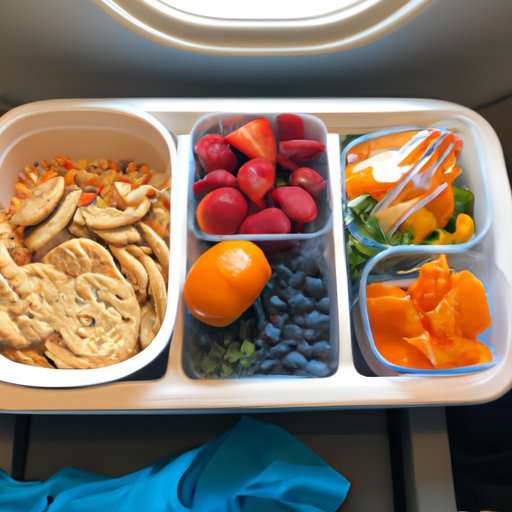Introduction
When traveling by plane, it’s important to be aware of the rules and regulations regarding what is allowed on board. One of the most common questions travelers have is if they are allowed to bring their own food on a plane. The answer is yes, but there are certain restrictions that must be followed.
The problem of bringing food onboard a flight is a real one for many travelers. It can be difficult to know what foods are allowed and which ones should be avoided. Additionally, it can be hard to find healthy and nutritious snacks for the journey. Fortunately, there are some simple solutions that can make it easier to bring food on a plane.
The benefits of bringing your own food on a flight are numerous. Not only will you save money by avoiding overpriced snacks at the airport, but you’ll also be able to ensure that you’re getting the nutrition you need while in the air. Additionally, bringing food on a plane can help reduce stress levels, as it eliminates the need to worry about what food will be available when you land.

A Guide to What Foods You Can Pack When Flying
When it comes to bringing food on a plane, it’s important to understand the TSA regulations. According to the TSA, solid food items such as sandwiches, fruits, vegetables, and other non-liquid items are allowed through security checkpoints. However, there are some exceptions. Anything that is considered to be a liquid or gel, such as yogurt, peanut butter, jam, and jelly, must be placed in a 3.4-ounce container or less and placed in a clear, plastic, quart-sized bag.
Another important thing to keep in mind when packing food for air travel is that all food items must be screened. This means that even if something is allowed, it may still be subject to additional screening. In order to speed up the process, it’s best to pack food items in a way that makes it easy for the TSA to inspect them.
How to Pack Snacks for Air Travel
When it comes to packing snacks for air travel, there are a few things to keep in mind. First, it’s important to consider the type of snacks you’re bringing. If you’re bringing food that needs to be kept cold or hot, it’s best to opt for insulated containers that can maintain the desired temperature. Additionally, it’s a good idea to choose snacks that are easy to eat. For example, granola bars, nuts, and dried fruit are all easy to eat and can usually fit in a carry-on bag.
It’s also important to think about how you’ll pack the snacks. Try to avoid packing too much food, as this can take up valuable space in your carry-on bag. Additionally, it’s a good idea to place all snacks in a resealable plastic bag to prevent any spills or messes. Lastly, make sure to label all snacks with your name and address so that they can easily be identified in case they need to be checked.

Plane Travel Tips: What Food to Bring Onboard
When it comes to deciding what food to bring on a plane, it’s important to consider what types of food should be avoided. Sugary snacks such as candy and chocolate are not recommended, as they can cause an energy crash. Additionally, processed and fried foods should be avoided, as they can cause bloating and indigestion. Lastly, it’s best to avoid caffeine, as it can cause dehydration.
Fortunately, there are plenty of healthy options when it comes to packing snacks for a plane ride. Fruits and vegetables are always a great option, as they provide essential vitamins and minerals. Nuts, seeds, and nut butters are also excellent choices, as they provide protein and healthy fats. Additionally, whole grain crackers and popcorn are great options, as they provide complex carbohydrates to keep you full and energized during the flight.

Eating Healthy While Flying: How to Bring Your Own Food
When it comes to eating healthy while flying, it’s important to plan ahead. Start by making a list of nutritious snacks you can bring on the plane. Stick to whole foods that don’t require any preparation, such as fruits, vegetables, nuts, and seeds. Additionally, look for snacks that are high in fiber and protein, as these will help keep you full and energized throughout the flight.
When packing your food for the plane, it’s important to consider how you’ll store it. Opt for reusable containers and bags that are easy to transport. Additionally, make sure to label all food items with your name and address in case they need to be inspected.
Conclusion
Bringing food on a plane can be a great way to save money and ensure that you’re getting the nutrition you need while in the air. It’s important to understand the TSA regulations and to plan ahead when packing snacks. Stick to whole foods that are high in fiber and protein, and make sure to pack them in a way that makes it easy for the TSA to inspect them. With a little bit of planning, you can get the most out of your flight by packing your own food!
The benefits of bringing your own food on a plane are numerous. Not only will you save money, but you’ll also be able to ensure that you’re getting the nutrition you need while in the air. Additionally, it can help reduce stress levels, as it eliminates the need to worry about what food will be available when you land.
(Note: Is this article not meeting your expectations? Do you have knowledge or insights to share? Unlock new opportunities and expand your reach by joining our authors team. Click Registration to join us and share your expertise with our readers.)
